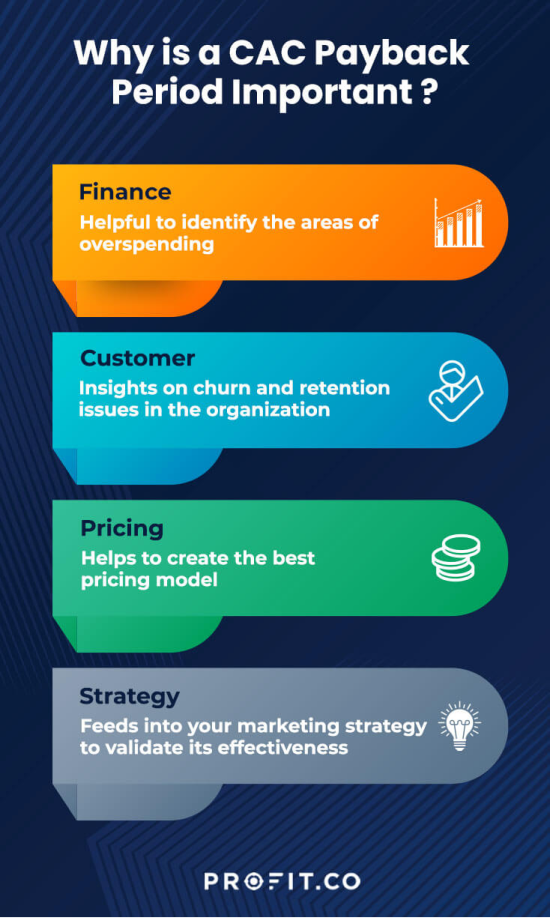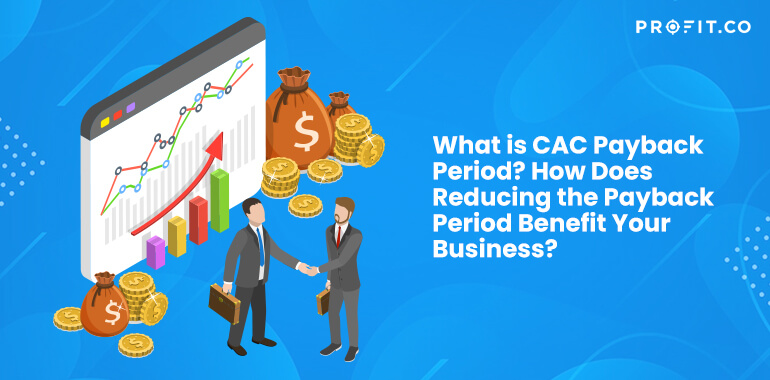Introduction
The cost of onboarding new customers has increased by more than 60% in recent years. With the current trends in digital marketing, the cost of advertising to increase the target customers has more or less doubled in recent years.
Acquiring new customers is an art and science. It is a culmination of not only a clever advertising strategy but a follow-up of the steps you take afterward that help you onboard new customers.
What is the Payback Period?
When you pay to acquire a customer, you don’t benefit from the investment immediately. You only enjoy the investment once their subscription revenue exceeds what you spent to achieve them. Every customer acquired by your SAAS Company has a SaaS payback period. The amount of time a customer takes to pay for their acquisition cost is the payback period. A shorter payback period leads to faster company growth.
Consider each customer that you bring in as an initial investment. You assume that you will get to a break-even point for every input, and the break-even point is a promise for future cash flow. Understanding your payback period lets you know how much you can spend on acquiring every customer, and your payback period determines your acquisition model’s efficiency.
Get closer than ever to your customers. So close that you tell them what they need well before they realize it themselves.
To maintain profitability, your company has to keep tabs on the CAC payback period. The CAC period is also the amount of money your company needs to continue to grow profitably. Understanding your CAC period determines your cash flow needs and also helps you to highlight issues with your marketing and customer retention strategies.
Payback Period Definition
The payback period is the duration it takes for a business to make back the money spent on acquiring a single customer. For example, the Payback period for a customer who costs 360$ to gain with a 20$ monthly subscription is 18 months. Over time, a customer’s iterative subscription payments help the business recoup the customer’s acquisition cost (CAC).
Why is CAC Payback Period important for a SaaS business?
Your payback period shows you how efficient your customer acquisition strategies are. Short payback periods are an indication of better, financially efficient acquisition methods. Understanding customer acquisition efficiency helps you understand the effect of different customer types on your organization’s finances. Customer acquisition efficiency also determines the sustainability of your investment decisions and strategies. Your goal should be to have a consistent cash flow all year. The accuracy of your payback method determines how fast you can start re-investing your money. More extended payback periods indicate that you must address the factors affecting the payback period.
The main objective of organizations is to reduce the payback period You can get started on Profit.co completely free today and find how to improve the efficiency of your organization!
Factors below concern the payback period
- Costs of customer acquisition
- Customer monetization
The higher the cost of customer acquisition, the longer the payback period, especially for subscription-based businesses.
Depending on your model of monetizing your customers, the amount of the monthly (or annual) increments that clients pay back their CAC will vary. You have three options for charging them: a set flat fee, customized plans, or usage-based pricing based on a value standard measure. Your customer’s payment plans determine how long the payment period will be.
The reasons a CAC Payback period is essential are
- It allows you to identify the areas you are overspending.
- It helps you isolate churn and retention issues: You must maintain each client if your business charges a monthly or annual payment that does not immediately offset the upfront purchase price. A more extended payback period increases the likelihood that you won’t recoup your acquisition costs.
- It helps you create the best pricing model: factors such as perceived product value, willingness and how much a customer is willing to spend, and determinants of a healthy margin.
- Feeds into your marketing strategy: the duration of the payback period might inform you if you are targeting the wrong market or whether you’re overspending on marketing
Calculation
How do you calculate Payback Period?
There are two methods of calculating the payback period:
- For an individual customer: divide their CAC by their annual revenue multiplied by 12, their monthly subscription.
- A group of customers: Divide the disparity in membership earnings between both quarters from the sales and advertising expenditures from the prior quarter (or year). You can then calculate how long it takes (in years) to recoup the initial cash outflow by dividing that result by four.
Payback Period Formula
According to GeckoBoard, you must know three other crucial barometers—Customer Acquisition Cost (CAC), Average Revenue Per Account (ARPA), and Gross Margin Percent if you want to calculate your company’s CAC Payback Period.
Formula:
- Customer Acquisition Cost / Average Revenue per Account.
- Multiply the outcome by the gross margin percent.
- Using this formula, you can tell how many months you need to recover the CAC.
For an individual customer, the payback period formula is as follows:
The payback period for Customer A = The cost of acquisition of the customer/ Annual revenue contribution
You can also calculate their payback period if you acquire a group of customers over a particular time (a month or a quarter). The calculation lets you know how many months or quarters you need to earn back the CAC.
The payback period for customers acquired in quarter three = Amount spent on sales and marketing in quarter 2/ [Quarter 3 revenue – Quarter 2 revenue]
Example of a Payback Period
For example, for a customer who costs $ 360 to acquire with a $ 20 monthly subscription and an annual subscription of $ 240 is 18 months:
Payback for the customer = $360 / $240 = 1.5 years = 18 months.

How Can You Reduce the Payback Period, And How Will It Impact Your Business?
A quicker turnaround time for CAC replenishment is essential to running your SaaS business successfully, generating income, and enhancing yearly cash flow. A healthy SAAS company, according to experts, needs an average one-year payback period. Due to various factors that affect your payback period, this duration varies over the years in a company.
Profiting in a short period indicates that your business is operating effectively. You will get your investment, leaving you with much more funds to experiment. With sales promotion, you can experiment with more significant risks to determine what draws in new clients (or turns them off).
The typical payback will alter as your company expands. The CAC payback period may lengthen or shorten depending on several variables, including market changes, increased competition, and additional operational costs. An investment’s payback period will typically vary early in a startup’s journey. However, anything under twelve months strongly indicates that the business is going in the right direction.
An investment’s CAC payback period for larger, well-funded SaaS businesses is much longer. Such companies have a more comprehensive range of resources, so they don’t have to move as quickly to turn a profit.
Since the payback period is not cast in stone, some tools exist to change the duration of making a profit. You need to experiment and understand both your business and your customers.
To reduce the payback period:
- Try out different pricing models: If your CAC is less than 12 months, promote an annual subscription. This allows the customers to save on a yearly purchase while you make a lump sum upon a customer’s signup.
- Analyze your marketing strategies and single out those with higher deal values: Use CRM systems and analytics to identify lead customer sources and average customer revenues across different platforms. Analyzing your marketing platforms allows you to prioritize between the other channels available depending on their revenue generation.
- Expand your business to target market segments with a higher value: Focusing on enterprise customers allows you to reduce your company’s CAC payback period. Identify how you can customize your products to meet the needs of these customers if you want to break into these markets.
- Upsell: Look inwards by expanding your expansion revenue, i.e., from selling to your existing customer base. Compared to acquiring new customers, the acquisition is much cheaper.
- Decrease churn: When customers leave before you break even on their cost of acquisition, you’re losing advertising money. Though churn is inevitable, exit interviews offer you a learning opportunity to understand the reasons for your customer’s departure. Analyze this information to improve your product.
FAQs
1. What is the meaning of the CAC payback?
It is the time a business takes to recover the cost of acquiring a customer.
2. What is a reasonable payback period in SaaS?
The best payback period is the shortest payback period possible.
3. How do you calculate the payback period for a CAC?
You divide the customer acquisition cost by the monthly recurring revenue.
Conclusion
With new businesses springing up overnight, “customer acquisition” is no longer just a marketing buzzword, and it’s now one of the most essential parts of your marketing strategy. At the end of the day, customer acquisition is about attracting the right kind of customers, the ones that not only stick around but go on to become brand advocates. Fine-tuning your customer acquisition process and learning what works best for your business will keep your cost of acquiring a new customer as low as possible. Book a free demo with our team to learn more about how OKR software can optimize your goals and help you achieve great customers!

